
Xplor reconnects kids to nature and helps them find adventure in their own backyard. Free to residents of Missouri.


































Stay in Touch with MDC news, newsletters, events, and manage your subscription

Xplor reconnects kids to nature and helps them find adventure in their own backyard. Free to residents of Missouri.

A monthly publication about conservation in Missouri. Started in 1938, the printed magazine is free to residents of Missouri.




Hatfield, Mo. – The Missouri Department of Conservation (MDC) wants to know what Missourians think about its nearly 1,000 conservation areas around the state. MDC is in the multi-year process of updating management plans for conservation areas and invites public comments. Draft plans for the Pawnee Prairie Natural Area are available for public comment through Sept. 30. The area is west of Eagleville in northwest Missouri.
To preview draft management plans and share comments online, visit www.mdc.mo.gov/areaplans.
Pawnee Prairie Natural Area offers a rare remnant of unplowed native Missouri prairie and restored grasslands. The prairie is part of the Grand River Grassland, a public and private partnership to restore functioning grassland ecosystems over a broad area to benefit plants, streams, and wildlife, including endangered prairie chickens. Hiking, photography and birding are among the popular activities on Pawnee Prairie’s 475 acres.
Statewide, MDC conservation areas cover almost one million public acres for the purpose of restoring and conserving forest, fish and wildlife resources, and for providing opportunities for all citizens to use, enjoy and learn about these resources. Most Missourians are within a 30-minute drive of an MDC conservation area.
Conservation Area Management Plans focus on natural resource management and public use on conservation areas. The plans do not address regulations on hunting, fishing and other area uses, which are set by the Conservation Commission and enforced under the Wildlife Code of Missouri. MDC will consider all ideas received and will work to balance the issues and interests identified with the responsibility of managing areas for the present and future benefits to forest, fish, wildlife, and people. Decisions on which ideas to incorporate into area plans and on how to best incorporate them will be based on the property’s purpose, its physical and biological conditions and capabilities, the best roles of the property in its local, regional and state-wide context, and on the professional expertise of MDC staff.